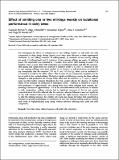Por favor, use este identificador para citar o enlazar a este item:
http://hdl.handle.net/10261/5033COMPARTIR / EXPORTAR:
 SHARE
BASE SHARE
BASE
|
|
| Visualizar otros formatos: MARC | Dublin Core | RDF | ORE | MODS | METS | DIDL | DATACITE | |

| Título: | Effect of omitting one or two milkings weekly on lactational performance in dairy ewes |
Autor: | Hervás, Gonzalo CSIC ORCID ; Ramella, Jorge L.; López, Secundino CSIC ORCID ; González, Jesús Salvador CSIC; Mantecón, Ángel R. CSIC ORCID | Palabras clave: | Assaf Dairy sheep Milking frequency Milk yield Milk composition |
Fecha de publicación: | 2006 | Editor: | Cambridge University Press Universidade do Estado de Santa Catarina |
Citación: | Journal of Dairy Research 73: 207-215 (2006) | Resumen: | We investigated the effects of omitting one or two milkings weekly on milk yield and milk composition in dairy sheep. Ninety Spanish Assaf ewes were allocated to three experimental treatments: T0 (no milking omission; 14 milkings/week), T1 (omission of one evening milking per week; 13 milkings/week) and T2 (omission of two evening milkings per week; 12 milkings/ week). The experiment was extended for 11 weeks, from week 7 after lambing to week 17 of lactation. Once a week, daily milk production was recorded just before and after the omission. Milk quality and composition was analysed in lactation weeks 9, 13 and 16. Omission of one or two evening milkings each week resulted in an increase in milk production recorded the day immediately after the omission (27% for T1 and 16% for T2), which can be attributed to accumulation of milk in the udder cisterns. This increase did not compensate completely for the loss of yield in the omitted milking. The lack of significant differences among the three milking strategies in milk production (on average 1903, 2062 and 1833 ml/d for T0, T1 and T2, respectively) recorded before omission throughout the trial, would indicate the absence of residual effects of the omission on production in subsequent weeks. Treatment T2 resulted in a loss of milk production of approximately 39% during those days when milkings were omitted, representing a decrease of approximately 10% of the estimated weekly milk production. In relation to milk composition, milking omission led to significant increases in the fat and protein concentrations of the milk collected after the omission, whereas differences were not significant for the milk obtained before the omission. Despite the slight increase observed in treatment T2 after the milking omission, the somatic cell count was always far below that considered as indicative of possible pathologies. In conclusion, at least one evening milking could be omitted each week in high-producing dairy sheep without adversely affecting milk yield and milk composition. | Descripción: | The definitive version is available at:http://dx.doi.org/10.1017/S0022029905001603 | URI: | http://hdl.handle.net/10261/5033 | ISSN: | 0022-0299 |
| Aparece en las colecciones: | (IGM) Artículos |
Ficheros en este ítem:
| Fichero | Descripción | Tamaño | Formato | |
|---|---|---|---|---|
| Hervás et al_2006.pdf | 117,29 kB | Adobe PDF |  Visualizar/Abrir |
CORE Recommender
Page view(s)
377
checked on 26-abr-2024
Download(s)
362
checked on 26-abr-2024
Google ScholarTM
Check
NOTA: Los ítems de Digital.CSIC están protegidos por copyright, con todos los derechos reservados, a menos que se indique lo contrario.
